Climate Seasonality of Tropical Evergreen Forest Region
Abstract
1. Introduction
2. Materials and Methods
3. Results
3.1. The Global Tropical Forest Wet Season
3.2. Regional Division of the Global Tropical Forests
3.3. The Onset and End of the Wet Season in Global Tropical Forests
4. Discussion
5. Conclusions
Author Contributions
Funding
Data Availability Statement
Conflicts of Interest
References
- Bonan, G.B. Forests and Climate Change: Forcings, Feedbacks, and the Climate Benefits of Forests. Science 2008, 320, 1444–1449. [Google Scholar] [CrossRef]
- Malhi, Y.; Baldocchi, D.D.; Jarvis, P.G. The Carbon Balance of Tropical, Temperate and Boreal Forests. Plant Cell Environ. 1999, 22, 715–740. [Google Scholar] [CrossRef]
- Poveda, G.; Waylen, P.R.; Pulwarty, R.S. Annual and Inter-Annual Variability of the Present Climate in Northern South America and Southern Mesoamerica. Palaeogeogr. Palaeoclimatol. Palaeoecol. 2006, 234, 3–27. [Google Scholar] [CrossRef]
- Nyasulu, M.K.; Fetzer, I.; Wang-Erlandsson, L.; Stenzel, F.; Gerten, D.; Rockström, J.; Falkenmark, M. African Rainforest Moisture Contribution to Continental Agricultural Water Consumption. Agric. For. Meteorol. 2024, 346, 109867. [Google Scholar] [CrossRef]
- Saleska, S.R.; Didan, K.; Huete, A.R.; Rocha, H.R.D. Amazon Forests Green-Up during 2005 Drought. Science 2007, 318, 612. [Google Scholar] [CrossRef]
- Doughty, R.; Köhler, P.; Frankenberg, C.; Magney, T.S.; Xiao, X.; Qin, Y.; Wu, X.; Moore, B. TROPOMI Reveals Dry-Season Increase of Solar-Induced Chlorophyll Fluorescence in the Amazon Forest. Proc. Natl. Acad. Sci. USA 2019, 116, 22393–22398. [Google Scholar] [CrossRef]
- Guan, K.; Pan, M.; Li, H.; Wolf, A.; Wu, J.; Medvigy, D.; Caylor, K.K.; Sheffield, J.; Wood, E.F.; Malhi, Y.; et al. Photosynthetic Seasonality of Global Tropical Forests Constrained by Hydroclimate. Nat. Geosci. 2015, 8, 284–289. [Google Scholar] [CrossRef]
- Wu, J.; Albert, L.P.; Lopes, A.P.; Restrepo-Coupe, N.; Hayek, M.; Wiedemann, K.T.; Guan, K.; Stark, S.C.; Christoffersen, B.; Prohaska, N.; et al. Leaf Development and Demography Explain Photosynthetic Seasonality in Amazon Evergreen Forests. Science 2016, 351, 972–976. [Google Scholar] [CrossRef]
- Marengo, J.A. Interdecadal Variability and Trends of Rainfall across the Amazon Basin. Theor. Appl. Climatol. 2004, 78, 79–96. [Google Scholar] [CrossRef]
- Nicholson, S.E. The ITCZ and the Seasonal Cycle over Equatorial Africa. Bull. Am. Meteorol. Soc. 2018, 99, 337–348. [Google Scholar] [CrossRef]
- Nicholson, S.E. A Review of Climate Dynamics and Climate Variability in Eastern Africa. In Limnology, Climatology and Paleoclimatology of the East African Lakes; Routledge: London, UK, 2019. [Google Scholar]
- Herrmann, S.M.; Mohr, K.I. A Continental-Scale Classification of Rainfall Seasonality Regimes in Africa Based on Gridded Precipitation and Land Surface Temperature Products. J. Appl. Meteorol. Climatol. 2011, 50, 2504–2513. [Google Scholar] [CrossRef]
- Odekunle, T.O. Rainfall and the Length of the Growing Season in Nigeria. Int. J. Climatol. 2004, 24, 467–479. [Google Scholar] [CrossRef]
- Benoit, P. The Start of the Growing Season in Northern Nigeria. Agric. Meteorol. 1977, 18, 91–99. [Google Scholar] [CrossRef]
- Thornton, P.K.; Jones, P.G.; Ericksen, P.J.; Challinor, A.J. Agriculture and Food Systems in Sub-Saharan Africa in a 4 °C+ World. Philos. Trans. A Math. Phys. Eng. Sci. 2011, 369, 117–136. [Google Scholar] [CrossRef]
- Cook, K.H.; Vizy, E.K. Impact of Climate Change on Mid-Twenty-First Century Growing Seasons in Africa. Clim. Dyn. 2012, 39, 2937–2955. [Google Scholar] [CrossRef]
- Wainwright, C.M.; Allan, R.P.; Black, E. Consistent Trends in Dry Spell Length in Recent Observations and Future Projections. Geophys. Res. Lett. 2022, 49, e2021GL097231. [Google Scholar] [CrossRef]
- Liebmann, B.; Marengo, J. Interannual Variability of the Rainy Season and Rainfall in the Brazilian Amazon Basin. J. Clim. 2001, 14, 4308–4318. [Google Scholar] [CrossRef]
- Huffman, G.J.; Bolvin, D.T.; Nelkin, E.J.; Wolff, D.B.; Adler, R.F.; Gu, G.; Hong, Y.; Bowman, K.P.; Stocker, E.F. The TRMM Multisatellite Precipitation Analysis (TMPA): Quasi-Global, Multiyear, Combined-Sensor Precipitation Estimates at Fine Scales. J. Hydrometeorol. 2007, 8, 38–55. [Google Scholar] [CrossRef]
- Singer, M.B.; Asfaw, D.T.; Rosolem, R.; Cuthbert, M.O.; Miralles, D.G.; MacLeod, D.; Quichimbo, E.A.; Michaelides, K. Hourly Potential Evapotranspiration at 0.1° Resolution for the Global Land Surface from 1981-Present. Sci. Data 2021, 8, 224. [Google Scholar] [CrossRef]
- Harris, I.; Osborn, T.J.; Jones, P.; Lister, D. Version 4 of the CRU TS Monthly High-Resolution Gridded Multivariate Climate Dataset. Sci. Data 2020, 7, 109. [Google Scholar] [CrossRef]
- Liebmann, B.; Bladé, I.; Kiladis, G.N.; Carvalho, L.M.V.; Senay, G.B.; Allured, D.; Leroux, S.; Funk, C. Seasonality of African Precipitation from 1996 to 2009. J. Clim. 2012, 25, 4304–4322. [Google Scholar] [CrossRef]
- Dunning, C.M.; Black, E.C.L.; Allan, R.P. The Onset and Cessation of Seasonal Rainfall over Africa. J. Geophys. Res. Atmos. 2016, 121, 11405–11424. [Google Scholar] [CrossRef]
- Marengo, J.A.; Nobre, C.A.; Tomasella, J.; Oyama, M.D.; Oliveira, G.S.D.; Oliveira, R.D.; Camargo, H.; Alves, L.M.; Brown, I.F. The Drought of Amazonia in 2005. J. Clim. 2008, 21, 495–516. [Google Scholar] [CrossRef]
- Garreaud, R.D. The Andes Climate and Weather. Adv. Geosci. 2009, 22, 3–11. [Google Scholar] [CrossRef]
- Wright, J.S.; Fu, R.; Worden, J.R.; Chakraborty, S.; Clinton, N.E.; Risi, C.; Sun, Y.; Yin, L. Rainforest-Initiated Wet Season Onset over the Southern Amazon. Proc. Natl. Acad. Sci. USA 2017, 114, 8481–8486. [Google Scholar] [CrossRef]
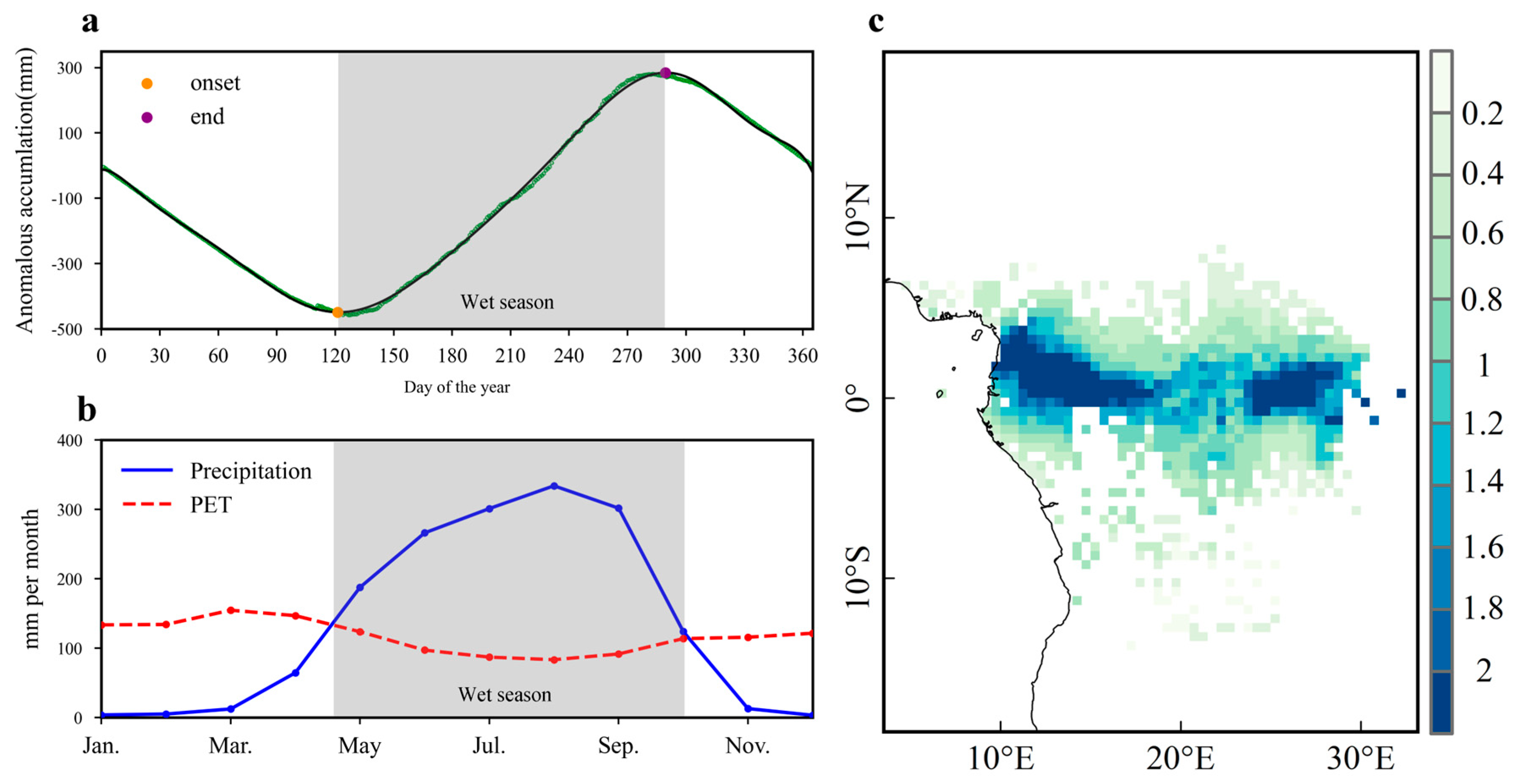
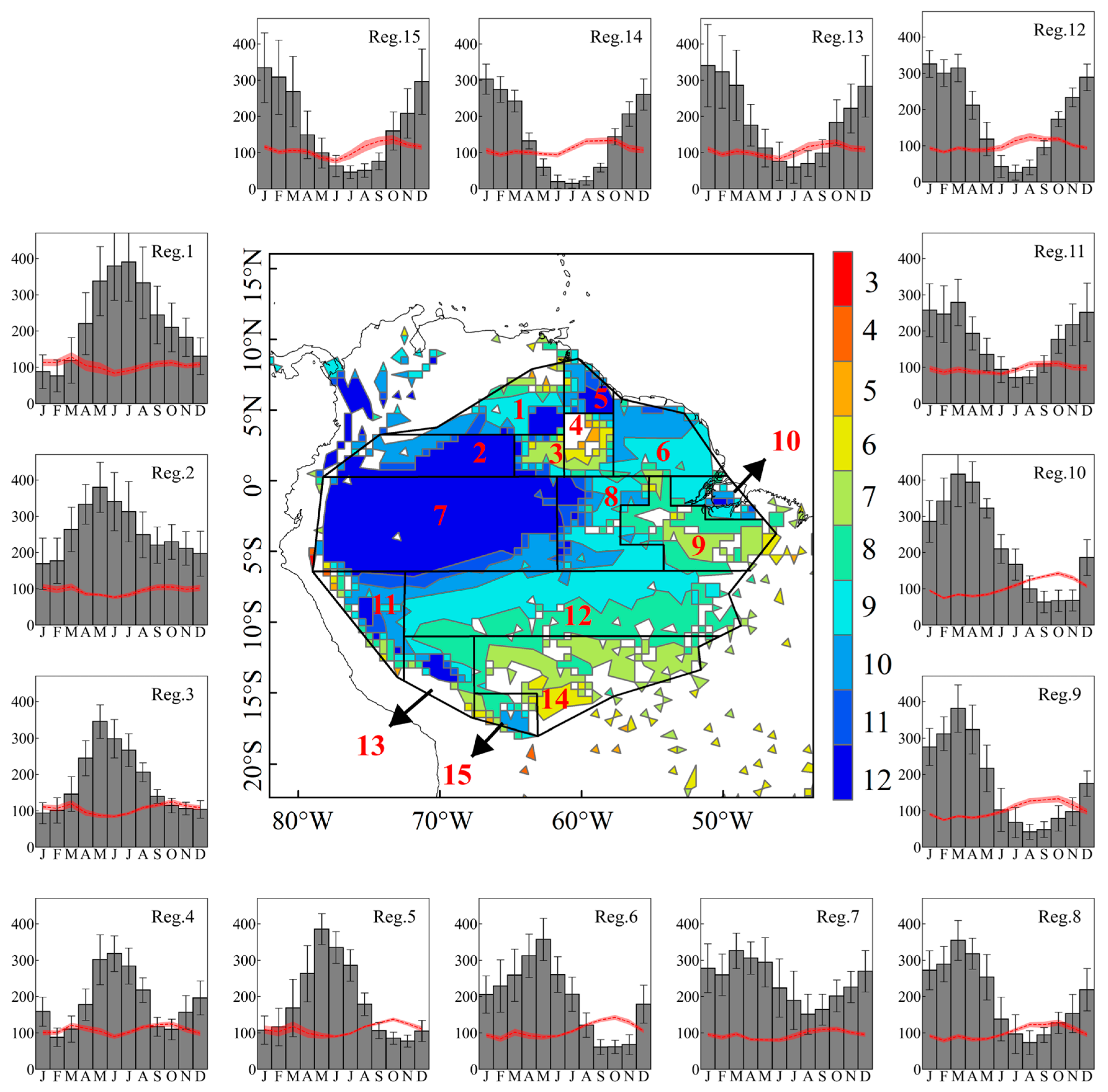
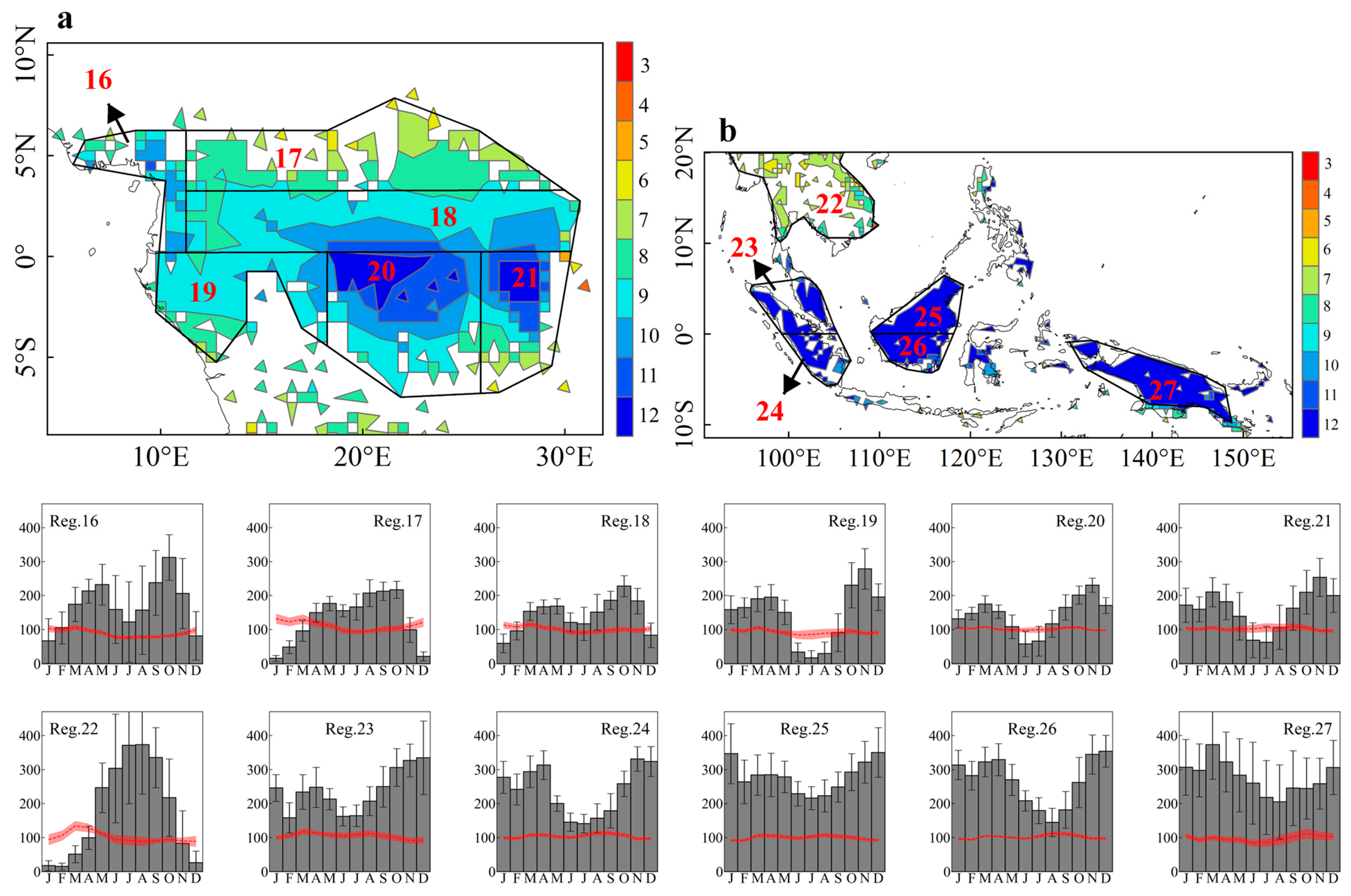

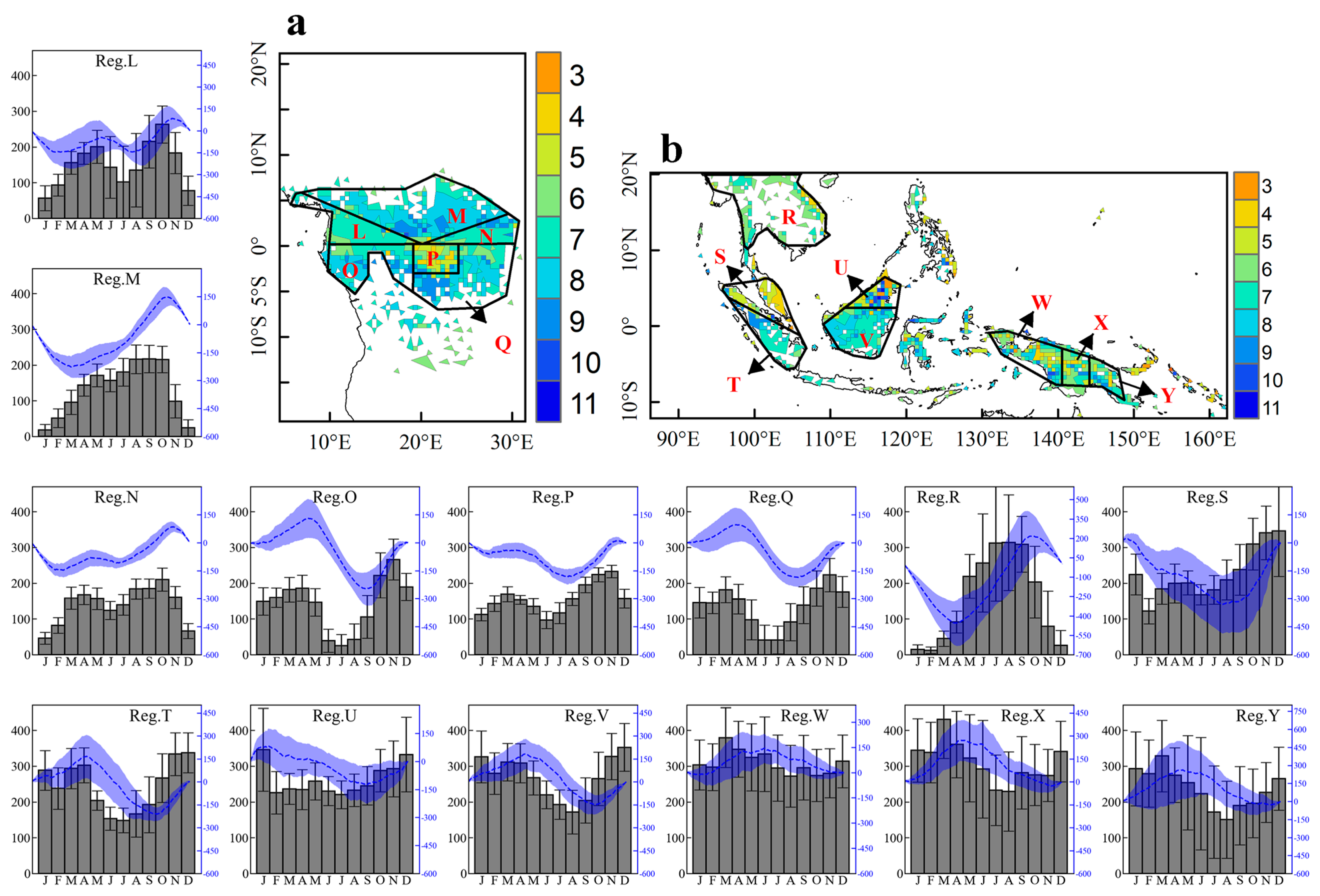

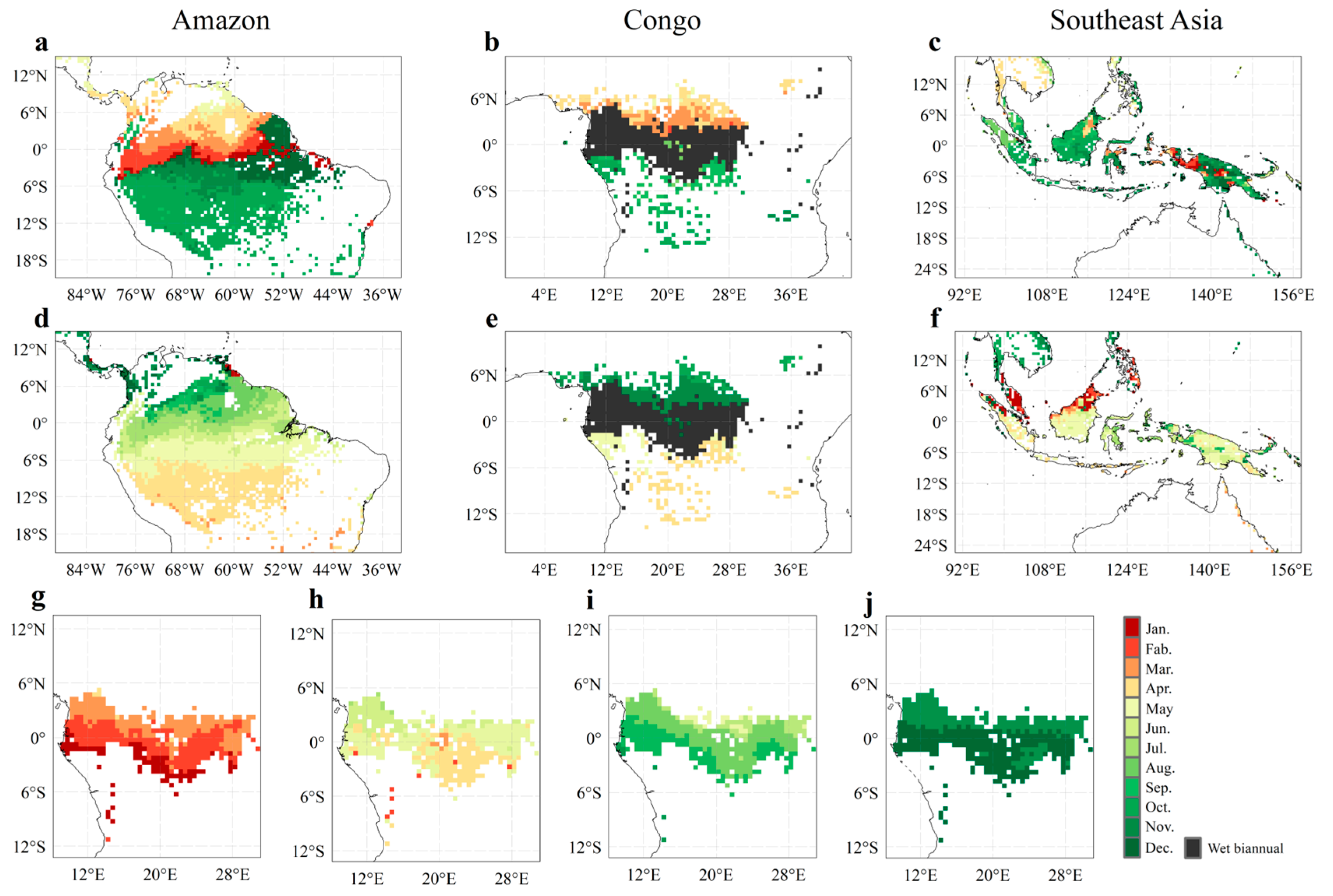
Disclaimer/Publisher’s Note: The statements, opinions and data contained in all publications are solely those of the individual author(s) and contributor(s) and not of MDPI and/or the editor(s). MDPI and/or the editor(s) disclaim responsibility for any injury to people or property resulting from any ideas, methods, instructions or products referred to in the content. |
© 2024 by the authors. Licensee MDPI, Basel, Switzerland. This article is an open access article distributed under the terms and conditions of the Creative Commons Attribution (CC BY) license (https://creativecommons.org/licenses/by/4.0/).
Share and Cite
Luo, L.-X.; Sun, Z.-Y.; Tan, Z.-H. Climate Seasonality of Tropical Evergreen Forest Region. Water 2024, 16, 749. https://doi.org/10.3390/w16050749
Luo L-X, Sun Z-Y, Tan Z-H. Climate Seasonality of Tropical Evergreen Forest Region. Water. 2024; 16(5):749. https://doi.org/10.3390/w16050749
Chicago/Turabian StyleLuo, Long-Xiao, Zhong-Yi Sun, and Zheng-Hong Tan. 2024. "Climate Seasonality of Tropical Evergreen Forest Region" Water 16, no. 5: 749. https://doi.org/10.3390/w16050749
APA StyleLuo, L.-X., Sun, Z.-Y., & Tan, Z.-H. (2024). Climate Seasonality of Tropical Evergreen Forest Region. Water, 16(5), 749. https://doi.org/10.3390/w16050749







